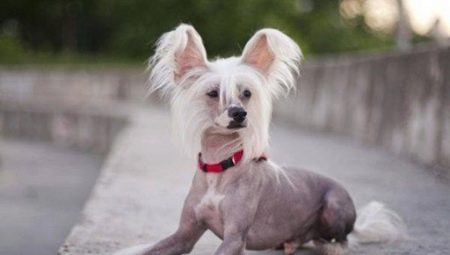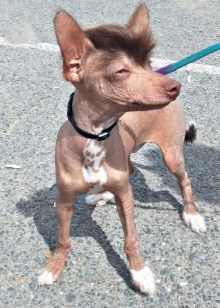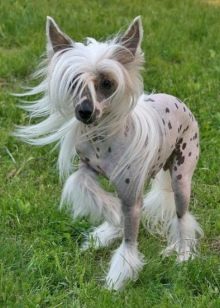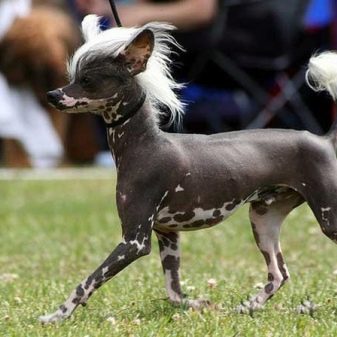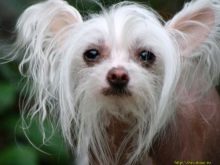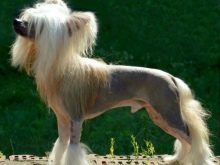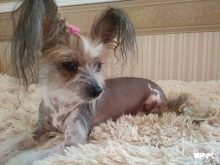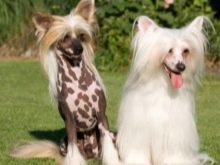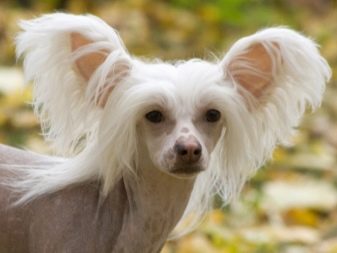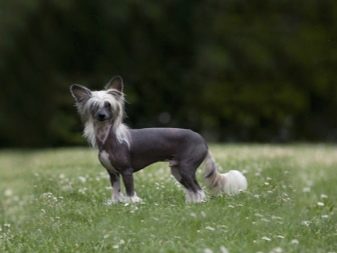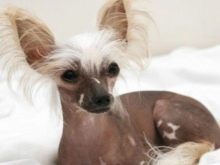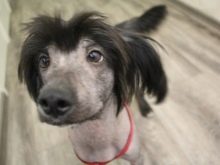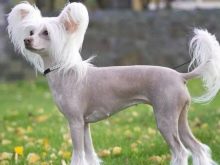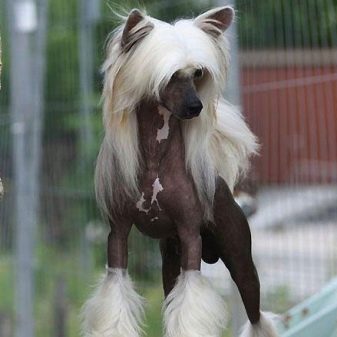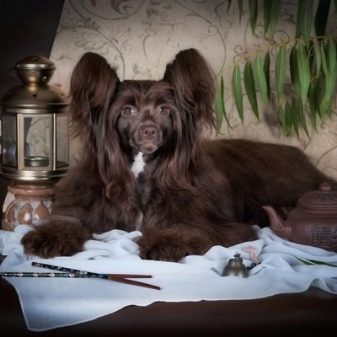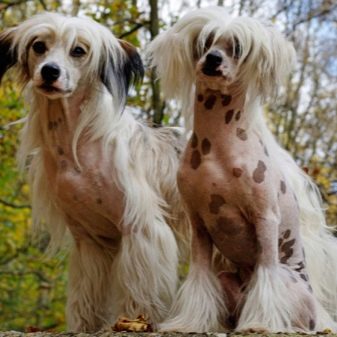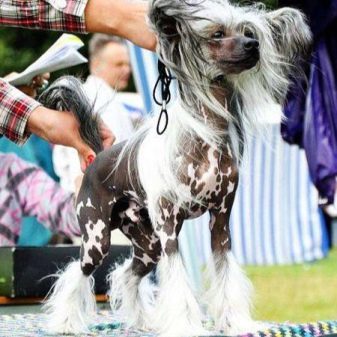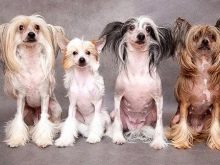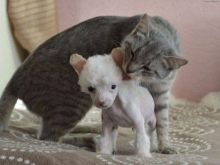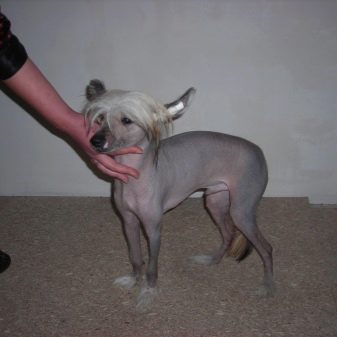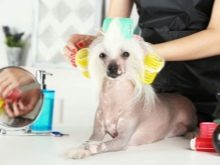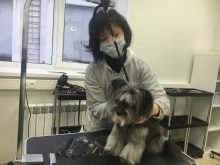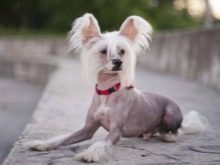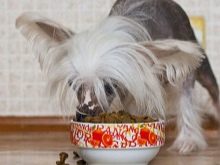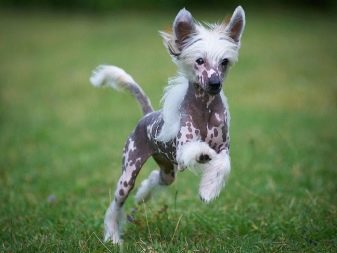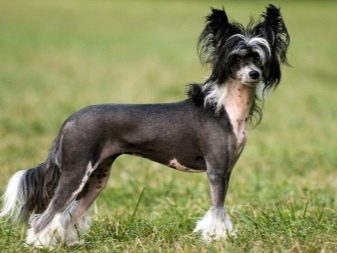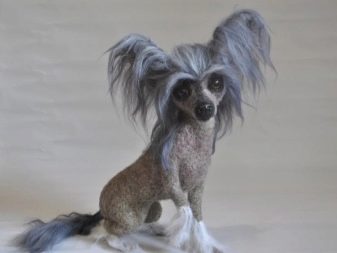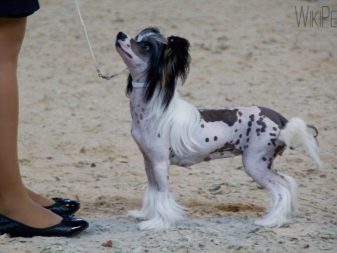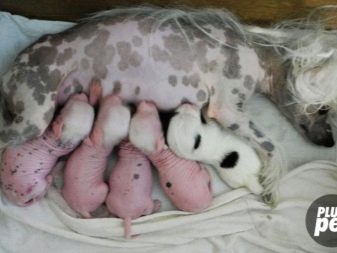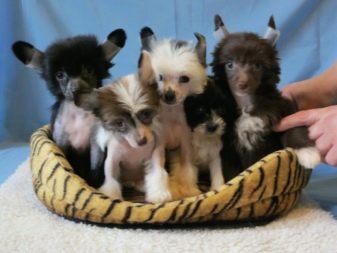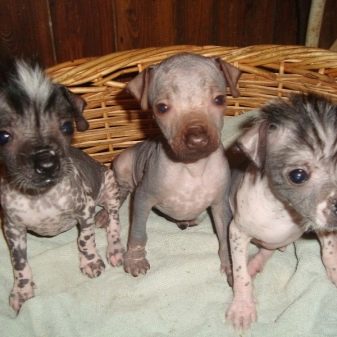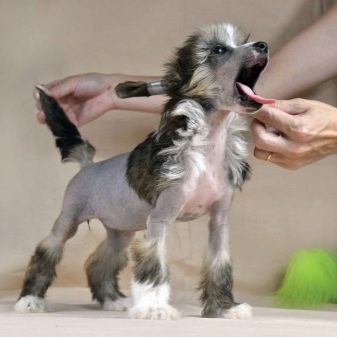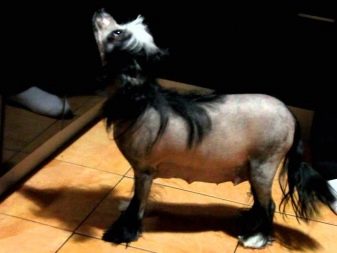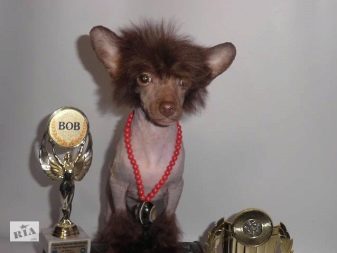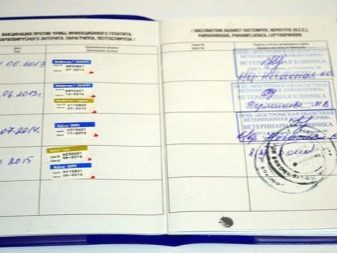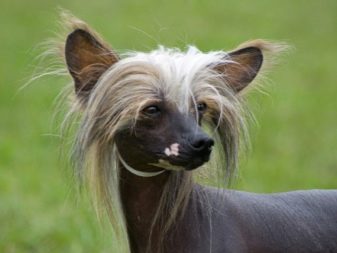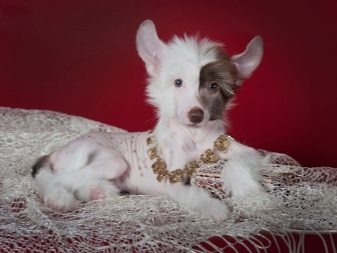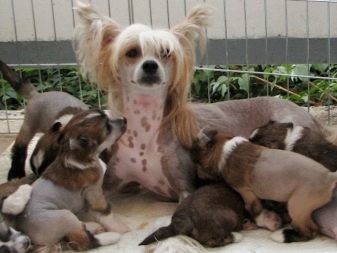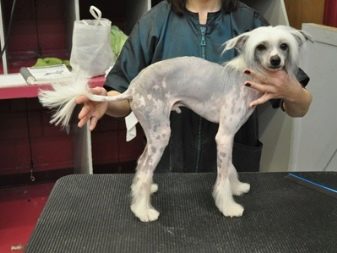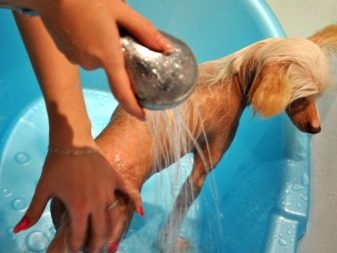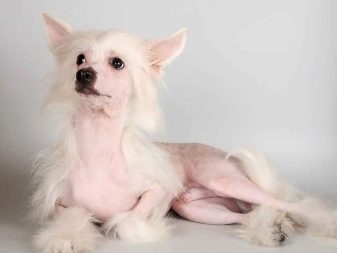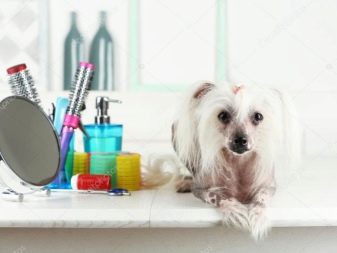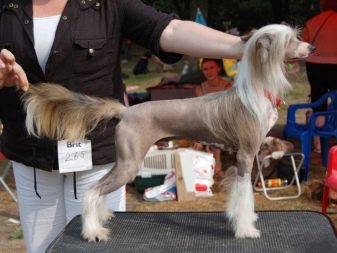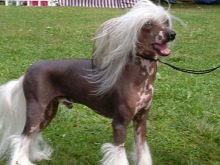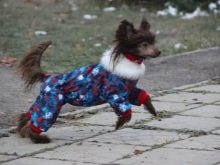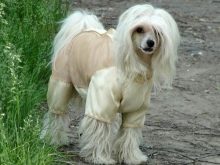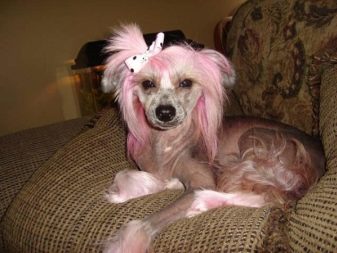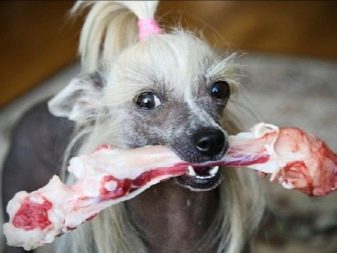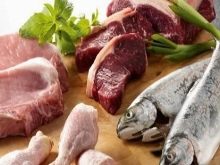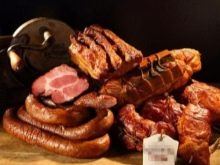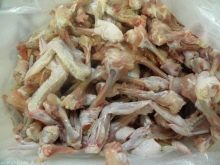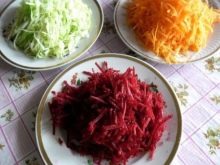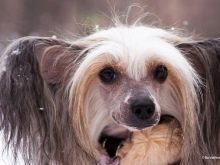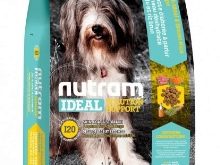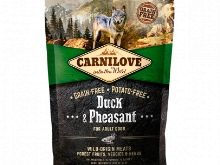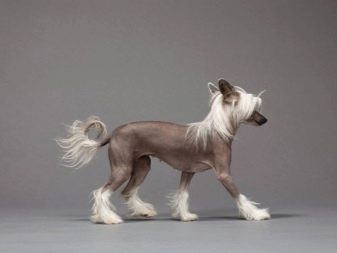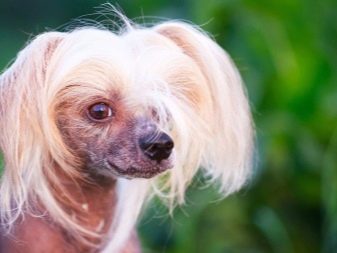Chinese Crested - a typical example of pocket dogs, which noble ladies in the Renaissance took with them to the high receptions and balls. These dogs are considered one of the most ancient breeds, in addition, they have a unique exterior and are famous for their friendly and kind character. In this article you will learn about the description of this breed, the history of its origin and the subtleties of content in the home.
History of origin
Modern breeders and dog handlers are not exactly sure of the birthplace of Chinese crested dogs (or KHS), but absolutely everyone agrees with the opinion that this is one of the most ancient breeds in the world. The most popular official version says that Africa and some regions of Mexico are home to these charming babies.
Even today, animals with a similar exterior are still found in regions with a subtropical climate. There they acquired their individual names, which differ depending on the locality.
So, individuals in Mexico are called Mexican dogs, in Egypt - Egyptian, in Peru - Peruvian.
Some dog experts say that the first representatives of this breed appeared 3,000 years ago, but the first documented data about these dogs date back to the 9th-12th centuries. At that time, these dogs had a high status, their breed belonged to one of the 10 symbols of the Kingdom of the god Ketsakoatl. The individuals of this breed symbolized virtue, love and devotion. Already at that time, people noted the extraordinary loyalty of these animals to their owners, they were considered a living example of unselfishness and trust.
Especially interesting is the purpose of these dogs at different times and in different nations. For example, around the tenth century, these dogs were placed in sick people’s beds. They allocated a huge amount of pleasant heat, which was considered healing among the healers of that time.
The Indians held superstition that these dogs are incarnations of deities and are able to heal from the mass of diseases.
These dogs were always kept to themselves - it was believed that they heal toothache, rheumatism, paralysis, and some other diseases associated with the bone system. The midwives advised to take these animals for the birth of noble women - it was believed that they facilitate the exit of the baby from the womb, prevent the formation of colic and soothe the baby.
This breed received its name due to the country where these dogs became a full-fledged breed. According to the records, these dogs got into China in the III-II century BC (during the Han dynasty). These cute miniature dogs are so fond of the Chinese that they began to actively spread throughout the state. Even then, the inhabitants of the Celestial Empire were engaged in breeding this breed and forming its standard.
As expected, The first owners of these pets were precisely the rich and noble Chinese nobles. It was believed that these dogs brought in the house well-being, prosperity and stability. This situation lasted until the 16th century, when these dogs began to be actively exported out of state borders on merchant ships. In the future, this led to the spread of the breed throughout Eurasia.
Proof of the great popularity of this breed are records in the stud books of Spanish, English and French breeders and travelers of the XVI-XIX centuries. Some of them stated that already in the XVII century these animals were met in North America and Africa.
This breed was able to get true fame only by the end of the 19th century - they began to actively breed it in European and American nurseries, and the price for individual individuals dropped significantly.
At the beginning of the XXI century, the situation with the origin of these dogs was clarified due to large-scale archaeological excavations. Historical data proves that the territories of these dogs are the home of Mexico and Central America, from where these dogs immigrated to the rest of the territory in the future. The most important evidence of this theory is the Mayan pottery fragments found on the island of Yucatan. Primitive images of “naked” dogs were found on ceramic products, and the products themselves were found not far from the burial sites of these animals, as evidenced by the mummified remains.
All signs indicate that These dogs were extremely revered among the ancient tribes. According to ancient manuscripts, they were often buried next to the owners - they were supposed to be the guides of their owners in the afterlife. In the language of the Aztecs, individuals of this breed have a strange and mysterious name - xoloitzkuitli. From the ancient language it is translated as "the dog of God Xolotl".
In Russia, the first individuals of this breed appeared only at the end of the twentieth century. The popularity came to them almost immediately - rich Russian ladies came to the delight of the extravagant appearance of these animals.
Description
Chinese crested dog is very easy to distinguish from all the others. No one else has such a soft fur on his paws and eyebrows, as well as a hairless graceful body. According to the ICF standard, this breed is represented by the following appearance characteristics.
- Body The skeleton is lightweight, the body is rather elongated than square, but proportional and elegant. The main muscle groups are located on the shoulder blades and hips. The back is even, the croup is extremely rounded, not particularly steep. The length of the hull can vary considerably depending on the type of CSC (for example, deer and chunky). Oleniy type is proportional: represented by an equal ratio of the length of the animal and its height, individuals of the stocky type are lower, and their body is slightly elongated. The thorax of the specimens of this breed is quite wide, the stomach is tucked up.
- Head and muzzle. It is proportional in relation to the body of the dog, not particularly large. The skull is rounded, but due to the long and narrow muzzle it seems elongated. Stop (or the transition from the forehead to the face) is smooth, weakly expressed.
- Jaws and Teeth. These dogs are distinguished by strong and powerful jaws, tightly assembled and strong teeth. The bottom row of teeth completely overlaps the top row. For individuals of the hairless type, the absence of the main number of molars is characteristic (they simply do not erupt). This is a genetic pathology that is not considered a defect.
- Nose. Not particularly large, well developed nostrils. The color of the nose in this case is not regulated by anything; pigmentation with lighter or darker spots is possible. Most often it is the dark shade of the nose.
- Ears. Usually covered with a thick layer of wool length (which can grow both from the outside and in the shells themselves). The ears themselves are long, erect, the tips are most often rounded, but they are also sharp. In feather-like individuals, a hanging type of ears is permissible. The ears are set at a great distance from each other, with the outer side looking forward.
- Eyes. Small in size, rounded and moderately convex, set wide apart. The color of the iris is extremely dark, but brown-eyed or blue-eyed individuals are found.
- Neck. Long and rather thin, there is a visible bend that can be clearly seen at the moment of movement of the dog.
- Limbs. At KHS legs are not powerful, thin, straight, front ones stand parallel to each other. Shoulders narrow, look back. Unlike other breeds, there are no visible knees on the hind legs, there is a slight forward bend, while the hind legs are longer and more massive than the front ones. The hock is too low, which does not allow the dogs to make long jumps or move quickly. The paws themselves are not particularly large, oval and extended forward. From the pasterns to the paws of the legs of dogs usually covers a thick layer of long wool.
- Tail. Regarding the size of the dog itself is quite long and either covered with long hair, or with a tassel at the very end. Some people call this type of hair growth a plume. In motion, it is raised and slightly bent, in a calm state it is lowered down.
- Leather. Gentle and rather thin, in naked individuals pinkish, white or gray (color depends on color). Skin pigmentation with small, but distinct specks of a contrasting color is permissible. Zonal pigmentation of large areas is also possible.
- Wool. The breed belongs to the long-haired look. The standard allows several options for the growth of wool on Chinese crested dogs. If the individual is "naked", then the wool is permissible on the paws, tail, head and ears. If it is a powder-puff (a type of CHS), then the location of the fur over the whole body of the animal is allowed, with the exception of the chest and the muzzle. The standard in terms of the location of the wool is very vague, but the main condition is the presence of a long and soft hair on the head. From birth, the individuals of this breed look like real sheep because of their miniature size and curly cannon on the body.
- Color. Unlike other dog breeds, Chinese Crested are not limited to the standard regarding color. All common types are allowed, including various types of skin pigmentation in naked individuals. In the territory of the Russian Federation, 20 types of color coats are officially recognized. The most popular ones are solid white, cream, light pink, solid black, white and black, chocolate, bronze, sable, blue, white and blue, tricolor, black and tan.
- Average weight These dogs belong to the type of breed "mini". Regardless of the variety of these dogs, they rarely reach a weight of 6 kg. Most often it is 4-5 kg.
- Growth. Males are standardly slightly higher than females, but the height of both of them does not exceed 30 centimeters at the withers.
Character
Outwardly, individuals of Chinese crested dogs seem pretty, obedient and well-mannered, but if it comes to the characteristics of the nature of this breed, everything is not so simple.
These dogs are very curious, a trip to visit or to the street for them is a real journey into a sea of new smells and sensations. They will not rest until they have studied the entire territory of the apartment, up to the most distant corners. That is why these dogs are so difficult to protect from any particular areas in the house. Such adventures often lead to these dogs being poisoned by spoiled food, detergents or other household items.
These dogs are especially fond of different holes and crevices - they love to climb in them and often get stuck there, frightening and panicking.
Although these dogs seem very independent, they are very easy to offend or upset. Especially painful, these dogs react to open aggression and physical punishment. This can lead to the fact that the dog will become afraid of every rustle and any other sound.
For these dogs, there is nothing worse than being alone for long. From loneliness they wither, become inactive and weak, passive, unstable to diseases.
More than a day, these pets should not be left.
Chinese crested are stubborn, but not so much that it is difficult to control them during dog training.In this regard, they are suitable even for amateurs, because they have a good mind, quickly remember the commands and love to execute them exactly. Often Chinese crested dogs are represented at sports competitions. With an experienced coach, they are able to perform even the most complex teams.
Chinese Crested are friendly to other pets. They will not mind cooperative games, but they always ensure that personal space is respected. In relation to street animals, Chinese crested do not show a certain aggression - as a rule, they are well aware of the power advantage and dare only to compete with congeners of the same size.
Chinese crested are not particularly friendly to children. Kids during their games often stick to pets, can injure them. In addition, these dogs see children as potential rivals for the attention of the owner. If a pet grows in a family with already enough adult children (8-10 years old), then no strong problems in their relationship will be noticeable.
A feature of these dogs is that they prefer not to become attached to any particular host.
They love to be universal favorites - it means receiving at the same time large portions of petting and delicacies from all family members.
Pros and cons of breed
Before you buy a particular breed of dog, The breeder must match the pros and cons of this variety. Chinese crested dog can not be called a uniquely unique breed, it has its pluses and minuses.
pros
- This breed of dogs is surprisingly convivial. For some owners, these dogs are a lively anti-stress due to their small size, pleasant fur and restless nature.
- Due to the insignificant coat (local type), these pets fade a little, and their wool has a unique fat layer, due to which neither dirt nor moisture stays on it for a long time.
- Due to its small size, weak moulting and good-natured character, this breed of dog is ideal for keeping at home. They do not need much space or food, they quickly adapt to the rhythm of their host’s life.
- Wool CSC does not have a characteristic dog smell, unlike many other dog breeds.
- These dogs are considered companions of rich women and aesthetes, they became one of the first dog breeds that were used as “pocket” dogs. Due to its extravagant appearance and small size, these dogs look great with any bow. In addition, these dogs can be made creative hairstyles, which will be the decoration and joy of the owner.
- KHS is absolutely not suspicious, it is easy to find an approach to them and to win over. They are wonderful to strangers - it’s enough just to gently entice them or give them sweetness, and now you have gained their trust. This is a plus, since there are no problems at the stage of domestication of already adult individuals.
Minuses
- Due to weak bones, frail build and weak limbs, these dogs are not suitable either as guards or as guards or working dogs.
- Due to the fact that a large part of the body of these dogs is not covered even with minimal wool cover, they are extremely susceptible to drafts, they do not tolerate cold and frost. For walking of these dogs in the late autumn, in the winter and in the spring, a blanket or special clothes will be needed. Also, do not walk these dogs in sunny weather without clothes - direct sunlight can greatly harm the delicate skin of the animal.
- Do not think that in the absence of molting all the problems of caring for the dog's fur disappear. In order for the wool to look neat and not dirty quickly, these dogs need to be regularly taken away for grooming sessions, as well as combing, washing and strengthening their fur with oils and nutrient solutions.
- Despite their seemingly small size, these dogs are unusually stubborn and often love to show their opinions and importance during training and walking. These dogs’s stubbornness can only be fought with patience and regular training.
- These dogs have a rather fastidious stomach, not all varieties of vegetables, feed or meat will suit them. Moreover, CSC is often capricious with respect to food and can refuse it if it is improperly brought up.
Lifespan
Chinese crested have quite good health and immunity, which have been formed for more than one hundred years. However, with the spread of the breed outside the territory of its warm homeland, the life expectancy of these dogs has changed dramatically. Thus, in the northern regions, due to long frosts and cold weather, even in the conditions of a warm apartment, these individuals live no longer than 10 years.
If it is a warm region with favorable environmental conditions, dogs of this breed can live up to 12-13 years.
It should be understood that such a concept as life expectancy is rather vague and depends on a number of factors.
- Conditions of detention, care. This is not the kind of dog you can just buy and forget about it. Chinese crested need painstaking and regular care, as well as safe and comfortable conditions of detention in order to feel healthy and cheerful. The main condition here - keeping the pet in a constant heat, without moisture and drafts.
- Feeding. The second most important factor that affects both the pet's health and its behavior, mood. Proper nutrition provides KHS with the necessary energy for daily adventures, as well as a positive effect on the development of muscles and the digestive system.
- Heredity. Some individuals are more or less predisposed to some kind of disease or ailment. Some of them appear only at a certain age and may not directly affect the life of the pet. However, some serious illnesses can significantly approximate your pet's aging or make it unhappy.
- Socialization. For such a social pet as a Chinese crested dog, establishing friendly relations with the owner simply has a huge role. Only by being confident in his devotion and love, the animal can feel relaxed and happy.
How to choose a puppy?
Puppies of this breed are sold in nurseries starting from a month and a half, however experienced breeders prefer to reserve pets in advance and assess the current conditions of their housing and feeding on the spot.
Close attention should be paid to the animal's woolen coat. Inspect the tail, head and ears of puppies - if there is thick hair, then in the future they will grow thick, if the hair is sparse, then in the future it is unlikely to increase. Often there are naked puppies that over time accumulate a thick layer of wool all over the body - this is not some kind of physiological defect. Abundant hair in naked dogs usually means a strong and thick coat on the head and legs.
You just have to go and see the groom or shave your pet more often.
In the period from 1 to 3 months, the exterior of a Chinese crested dog can drastically change. Most often it concerns changes in color or proportions of the head. So, individuals with darker or chocolate wool may eventually acquire almost a snow-white fur coat. At about 3 months the form of the most important external element of this dog - the topknot is fully formed. The length of the head and muzzle in infancy is not worth measuring, it will probably change more than once.
As already said it is likely that a number of molars in newborn puppies with Chinese crested will not be fully formed. Assessing the condition of the puppy's teeth, you can choose for him more hard or soft food.
You should not think that it will be easier for you to cope with a boy or girl with Chinese Crested.
The boys of this breed become literally out of control during the period of estrus in females, they are difficult to control and difficult to concentrate on training and even feeding. Often, such experiences lead to shoots during a walk. Girls have only two problems:
- in heat, during which the bitch behaves extremely excitedly and aggressively, and can also leave traces of blood along with secretions throughout the house;
- pregnancy, during which these dogs are very weak, prone to many diseases and mentally unstable.
It is possible to cope with this problem only by sterilizing the dogs (it is believed that it even prolongs the lifespan of the dogs), but who wants to deprive themselves of the care of small puppies of this breed? Chinese Crested puppies are not so expensive when selling from the hands, but purebred individuals from nurseries are very much appreciated among breeders.
Be sure to check availability all necessary documents. The standard package consists of a metric, pedigree and veterinary passport. Nurseries, for example, can acquaint you with the documents of the parents of the pet - so you can learn about the hereditary diseases and predispositions of your future pet.
Rate the conditions of the puppy - Private sellers often forget about elementary safety rules, which leads to the commonplace flea colonies in the fur of babies. Pay special attention to the pet's diet - it is very important to understand whether he received all the vitamins after birth. In addition, you will have an idea about the products that should be fed at first, so as not to cause problems with the gastrointestinal tract.
At about 2-3 months of age, the exterior of these animals is fully formed.
So you can find out about possible defects in appearance, you will accurately represent the color of the pet, the length of the body and head.
pay attention to puppy behavior. Between several individuals one should always choose the most active, restless and inquisitive. Such behavior speaks of good health and cheerful nature. However, note that excessive passivity, as well as anxiety (not to be confused with activity), often speak of serious puppy diseases or fleas.
Ask how many puppies were in the female's litter. If from 3 to 5, then these puppies must be healthy and strong. If more than 8, then this may indicate an inferior feeding of the pet in the first days after birth (lack of milk and maternal care).
Maintenance and care
Each dog needs care, as well as decent rules of maintenance, but this is especially true for gentle Chinese crested dogs.
For inexperienced breeders, the process of caring for these dogs may seem too tedious - it's all about the problematic skin of these dogs, which needs the same painstaking care as its fluffy fur. On the skin of these dogs, acne, "pro-grass", comedones and black spots are regularly formed, which can be removed only by steaming the skin.
In addition, the skin of these dogs needs regular washing (1 time per week for “nudes”, 1 time in 2 months for powder puffs) with natural hypoallergenic shampoos or baby soap.
In addition, rarely long hairs often appear on the skin of Chinese Crested, which greatly spoil the appearance of the dog. They can be removed with a wax, razor or regular depilatory cream (a more gentle method). After such procedures, the skin should be treated with an antiseptic or smear with an after shave balm.
In addition to skin problems, much of the attention should be paid to the hair of the animal. The fact is that even the "bare" types of CHS have bunches of hair on their chest, head, ears and limbs. Without regular brushing, adjustment, washing and oil treatment, this wool completely loses its appearance, forming one continuous dirty koltun.
Do not forget about regular hygiene procedures: cleaning the ears, clipping the claws (as needed), cleaning the teeth, washing the eyes with cotton pads. All these procedures should be carried out at least 1 time per week. In the ears of these dogs, real thickets of long hair often grow, which can interfere with brushing - they can be pulled out or clipped, but try not to harm the pet. For washing the eyes, use filtered or boiled water or a special veterinary lotion.
Grooming is one of the main points of care for show dogs of these dogs. The success of a dog at competitions depends on the correct and beautiful hairstyle. There are different options for grooming these dogs, but the best way to cut a dog is as follows:
- the entire body of the dog is shaved or shortly gelled;
- the limbs (before the start of the metacarpus) and the muzzle are also shaved (up to the foot and eyebrows);
- the length of the hair at the crown, eyebrows, tail and paws is maintained and adjusted to the same length;
- hair on the top of the head and eyebrows combed and laid so as not to interfere with the dog to see;
- the hairstyle is adjusted to the desired shape and fixed with wax, oil or hairpins.
Walking in the fresh air for these dogs is a kind of outlet where they throw out all the energy accumulated during the day. These dogs should be walked at least 1 time per day. Do not think that a dog of this size will not be able to harm anyone, and therefore ostensibly it is not necessary to walk it on a leash. In the course of their research, these dogs may fall behind or face a stronger street animal. In sunny weather, you should not walk these dogs without sunscreen on their skin.
In winter and autumn, these pets walk very rarely and always in warm clothes.
Little tricks in the care of Chinese crested dogs.
- No matter how you comb the wool of such a pet, it will still be tangled into mats. However, their density depends on the regularity of combing - the less dense the mats, the easier it will be to comb them the next time. If the mats are solid and can not be combed or simply interfere with the pet - they should be trimmed carefully, without damaging the entire hairstyle.
- All procedures with a comb should be carried out only on wool moistened with lotion. Dry hair when combing electrifies and sticks out in all directions. In addition, the chance to harm the structure of moistened wool is not so great.
- You will often encounter a situation where the hair at the withers or eyebrows will interfere with the view of the animal. This wool can be fixed with rubber bands and pins.
- It is not worth taking shish-kebabs or just into the “naked” forest. There are usually many insects in nature, against which these dogs have no protection.
Feeding
The main condition for feeding Chinese Crested Dog is the complete elimination from the diet of all types of human food: salted, spicy, smoked, pickled foods. All this food will badly affect your pet's body and will certainly lead to indigestion.
Unfortunately, Chinese crested are not distinguished by a strong intestine, which is able to digest absolutely all types of food. This is especially true of feeding with natural products, where even the most minimal diet change has a detrimental effect on the processes in the digestive system.
That is why you should be extremely cautious about any new products in the dog menu.
The problems of the digestive tract is not the only scourge of Chinese crested. They are often susceptible to allergies to cereals and vegetables. - The main elements in the diet of any pet. All this is expressed in an absolutely impartial form: redness of the eyelids, swelling of the glands, swelling of the cheeks, wen, sneezing with a cold, itchy skin, vomiting and diarrhea. To understand what products the dog is not allergic, take her to a dog allergist or veterinarian.
The following foods are banned in the Chinese Crested diet: raw meat and fish, dairy products, pork and chicken (huge fat content / powerful allergen for “crested”), sausages and smoked products, products with sugar content (sweets, chocolate, cakes), bones (both tubular and ordinary - they form constipation, get stuck in the throat), some cereals (semolina, oatmeal and pearl barley).
Most of the benefits to individuals of this breed will be fermented milk products with low fat content (cottage cheese, cheese, kefir), some porridges on the water (corn, rice, millet), lean meat (veal, lamb, hare), apple, pear. Occasionally, you can add new foods to your diet. To replace the meat can be used boiled sea fish without bones. Vegetables are better to restrict carrots, beets and cabbage.
Feed the pet is worth after a walk. Exercise and a small run will tire the pet and wake up his appetite. DFor the morning feed, it is better to choose vegetable food - it is lighter, better digested even during the period of activity.
At the evening meal you should leave the meat or offal - during sleep and rest this food is absorbed much better.
As a dog grows older, its requirements for serving food also change - in older individuals, the intestines weaken, teeth crumble, and the gums become inflamed from the slightest solid food. Problems with teeth are often observed in the “bare” variety of CHS, in old age they have no teeth left at all. For a gentle attitude to the oral cavity, it is enough to chop food before serving to a pet, especially with meat.
Chinese Crested is exactly that breed of dog, the organism of which will perceive the finished feed as a more complete and useful food. This is especially true for pregnant KHS females - high-quality dry food contains all the necessary vitamins and elements for the development of fruits. When choosing such a feed is better to stay on hypoallergenic super premium or holistic feeds.
Popular nicknames
The owners of the Chinese Crested prefer to give their pets cute and extraordinary names, which simultaneously emphasize the exclusivity of the individual, its small size, tenderness and playful character.
Most often the following nicknames KHS:
- for boy: Archie, Nemo, Yasha, Amur, Aysik, Joyce, Dan, Ryu, Jiro, Hiro, Hayako, Shino, Jerry, Shelton, Sweet;
- for girl: Hoshi, Daphne, Miya, Aiko, Oji, Ran, Notti, Ty, Alice, Grace.
Some breeders prefer to choose precisely eastern names for such pets. So they want to emphasize the belonging of the pet to the Chinese culture. Each such nickname designates a specific action or object.
About the features of the breed, see below.
